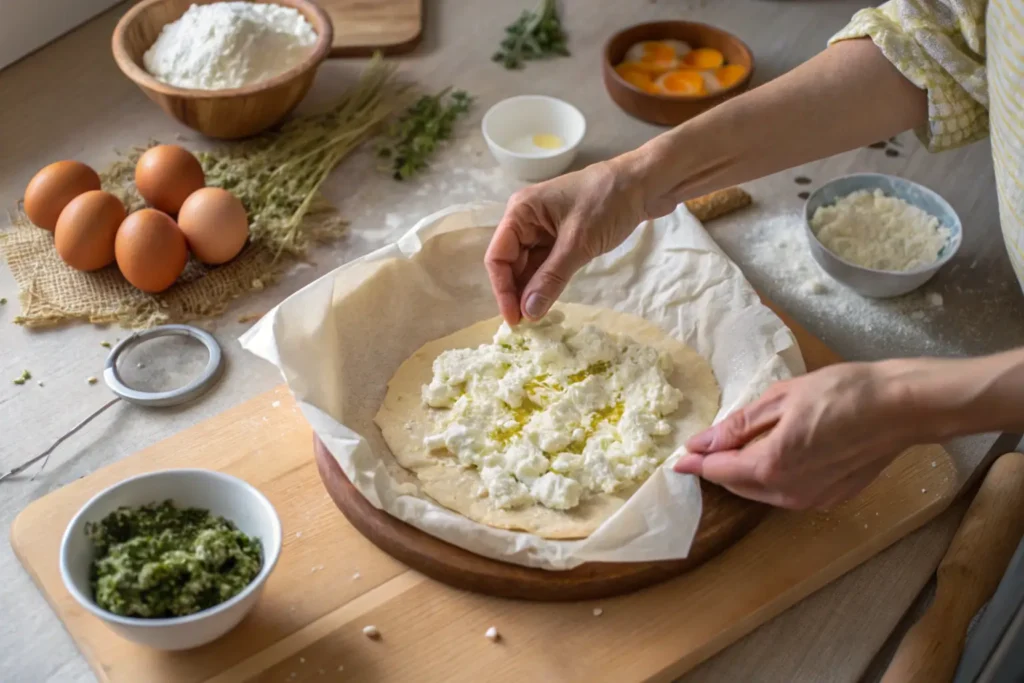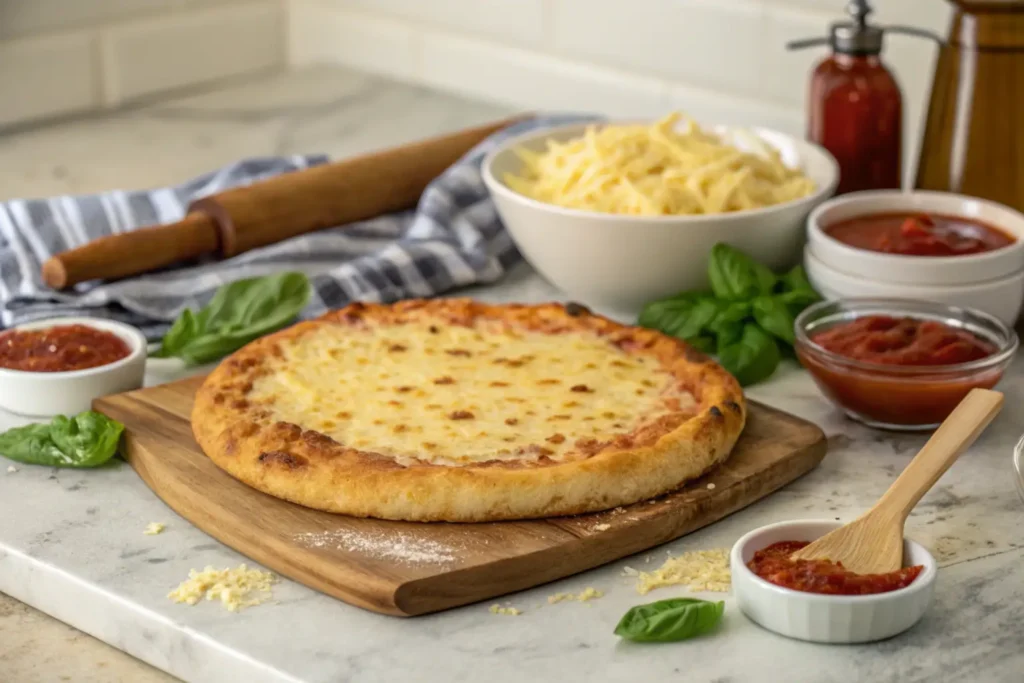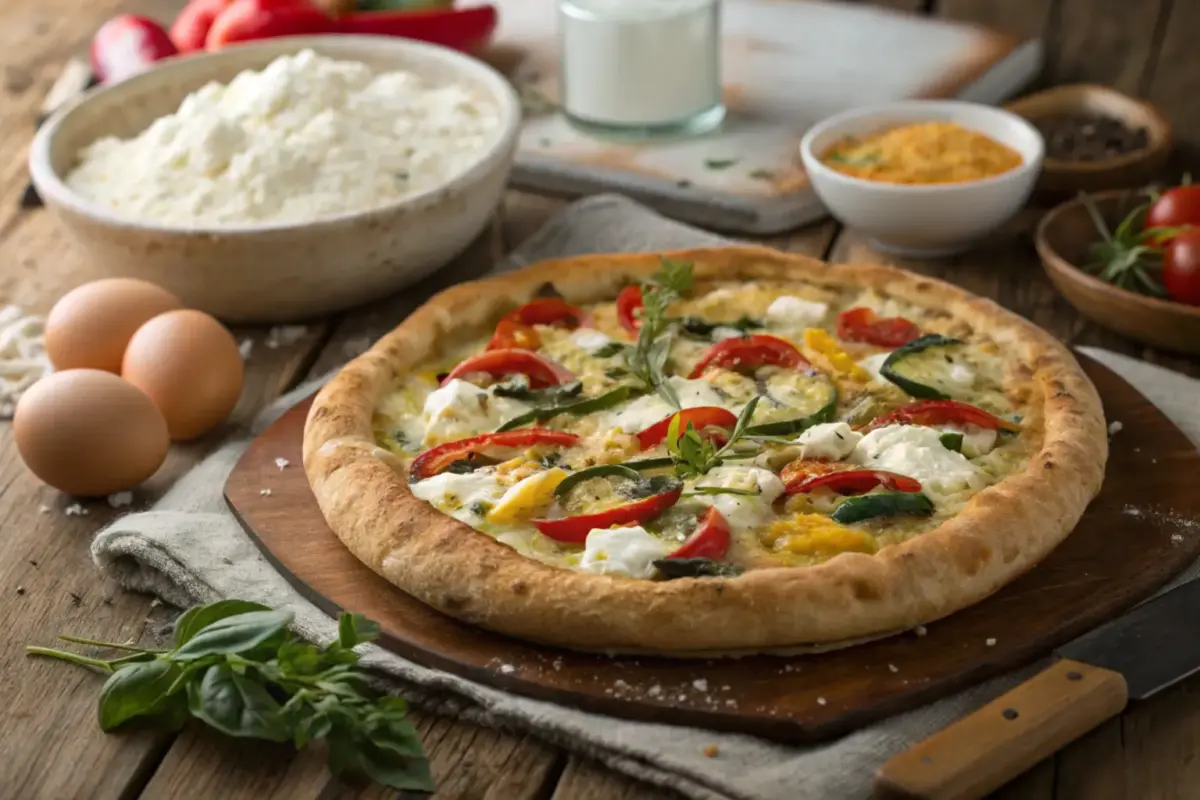What is Cottage Cheese Pizza Crust?
If you’re a pizza lover looking for a healthier twist, cottage cheese pizza crust might just be your new best friend. It’s a simple, wholesome base made with—you guessed it—cottage cheese, offering a lighter alternative to traditional pizza dough. This crust keeps things fluffy and flavorful while packing in more protein and fewer carbs. Whether you’re on a health kick or just curious, it’s worth giving this recipe a try.
In search of more meal ideas? Discover our amazing recipe collection here!
The Origins of This Unique Recipe
The idea of using cottage cheese in pizza crust isn’t as new as it might seem. With the rise of low-carb and keto diets, creative cooks started experimenting with high-protein ingredients to replace starchy flours. Cottage cheese quickly became a favorite thanks to its mild taste and creamy texture. Today, it’s a go-to option for anyone wanting a healthier, homemade pizza without sacrificing taste or satisfaction.
Why Cottage Cheese is a Game-Changer for Pizza Lovers
Let’s face it, pizza cravings are real. But what if you could satisfy those cravings without feeling guilty? That’s where cottage cheese shines. It’s not only packed with nutrients but also blends seamlessly into a crust that’s crispy on the outside and soft on the inside. Plus, it’s super versatile—you can pair it with all your favorite toppings without overpowering the flavors. Think of it as your pizza night upgrade.
Benefits of Using Cottage Cheese in Pizza Crust
Nutritional Advantages Over Traditional Crusts
Traditional pizza dough is often loaded with refined flour and empty calories. Cottage cheese crust flips the script by delivering protein, calcium, and a boost of vitamins. It’s a smarter choice for those wanting to fuel their bodies without skimping on taste. With fewer carbs and more essential nutrients, this crust helps you stay on track while still enjoying every bite.
Low-Carb and Keto-Friendly Options
Carb-conscious eaters, rejoice. Cottage cheese pizza crust is naturally lower in carbohydrates, making it a favorite for keto enthusiasts. By replacing traditional flour with almond flour or other low-carb options, you can create a crust that fits seamlessly into your dietary goals. And trust me, it’s just as satisfying as the classic version—if not more.
Gluten-Free and Allergy-Sensitive Alternatives
For those with gluten sensitivities or allergies, cottage cheese crust is a dream come true. By swapping out wheat-based ingredients, you can craft a gluten-free pizza that’s both delicious and easy on the stomach. Plus, it’s a fantastic way to accommodate various dietary needs without compromising on flavor or texture. Who says you can’t have it all?
How to Make Cottage Cheese Pizza Crust from Scratch

Essential Ingredients You’ll Need
Making cottage cheese pizza crust is surprisingly simple, and you don’t need a long list of fancy ingredients. Here’s what you’ll want to gather: cottage cheese (obviously), eggs for binding, almond or coconut flour for structure, and a pinch of salt for flavor. Optional add-ins like garlic powder or Italian seasoning can kick up the taste. It’s the kind of recipe you can whip up with pantry staples—no last-minute grocery runs required.
Step-by-Step Preparation Guide
First, preheat your oven to 400°F and line a baking sheet with parchment paper. Blend the cottage cheese, eggs, and seasoning in a food processor until smooth. Next, add your choice of flour slowly, mixing until the dough reaches a workable consistency. Spread the mixture onto the parchment paper in a circular or rectangular shape, depending on your vibe. Pop it in the oven for 10-15 minutes, then let it cool before adding toppings. Easy peasy, right?
Tips for Achieving the Perfect Texture

The trick to getting that perfect crust lies in the balance of moisture and firmness. If your dough feels too wet, don’t panic—just add a little more flour, one tablespoon at a time. For an extra crispy base, bake the crust a little longer before adding your toppings. And don’t forget to let it cool slightly after baking; this helps it hold its shape better when loaded with delicious toppings.
Baking Techniques for the Best Results
Oven Settings and Cooking Times
Baking your cottage cheese pizza crust just right is key to achieving that ideal texture. Preheat your oven to 400°F for a balanced mix of crispiness and tenderness. Bake the crust alone for about 10-15 minutes until it starts to set and turns a light golden brown. After adding your toppings, bake it for another 10-12 minutes. Keep an eye on it—ovens can vary, and no one wants a burnt pizza night.
Using a Pizza Stone vs. a Baking Sheet
If you’ve got a pizza stone tucked away in your kitchen, now is the time to use it. A stone can help distribute heat evenly, giving your crust that authentic pizzeria feel. Don’t worry if you only have a baking sheet, though—it works just as well. Just make sure to line it with parchment paper or a non-stick mat to prevent sticking and make cleanup a breeze.
How to Avoid Common Baking Mistakes
The most common issue people face is ending up with a crust that’s too soggy or flimsy. To avoid this, don’t overload your dough with wet toppings, and bake the crust fully before adding anything. Also, resist the urge to overmix the dough—it can make the texture too dense. Finally, make sure your oven is fully preheated before you start baking for consistent results.
Flavor Pairings and Topping Ideas
Classic Combinations for a Traditional Taste
You can never go wrong with a classic. Spread a rich tomato sauce over your crust and top it with mozzarella, pepperoni, and a sprinkle of oregano. For a veggie-forward twist, try mushrooms, bell peppers, and onions. These combos work beautifully with the mild, creamy flavor of the cottage cheese crust, keeping things comforting yet fresh.
Creative and Unique Topping Suggestions
If you’re feeling adventurous, go beyond the basics. How about a barbecue chicken pizza with red onion and cilantro? Or a Mediterranean-inspired version with feta, olives, and sun-dried tomatoes? For a breakfast vibe, try scrambled eggs, bacon, and a sprinkle of cheddar. The possibilities are endless, so let your imagination run wild.
Sauces That Complement Cottage Cheese Crust
Your sauce choice can make or break the flavor. A traditional marinara sauce is always a winner, but why not mix it up? Pesto brings a fresh, herby vibe, while Alfredo sauce adds creamy richness. For something lighter, a garlic-infused olive oil base works beautifully. Whatever you choose, make sure it complements your toppings for the ultimate pizza experience.
Storing and Reheating Your Pizza Crust
Proper Storage Methods for Freshness
If you’re making your crust ahead of time or have leftovers, proper storage is essential. Let the crust cool completely, then wrap it tightly in plastic wrap or store it in an airtight container. Keep it in the fridge for up to three days, and it’ll stay fresh and ready for your next pizza night.
How to Reheat Without Losing Crispiness
The trick to reheating is keeping the crust crispy. Skip the microwave—it tends to make the crust soggy. Instead, use an oven preheated to 375°F or a skillet on medium heat. For the oven, place the pizza on a baking sheet and heat for about 8-10 minutes. If using a skillet, heat it on low with a lid to trap heat and melt the toppings while keeping the crust firm.
Freezing and Thawing Instructions
Want to prep in advance? Freeze your baked crust for ultimate convenience. After it cools, wrap it tightly in aluminum foil or place it in a freezer-safe bag. When you’re ready to use it, thaw it overnight in the fridge or leave it on the counter for a few hours. Reheat it in the oven to bring back that freshly baked goodness before adding your toppings.
Comparing Cottage Cheese Crust to Other Alternatives
Cauliflower Crust vs. Cottage Cheese Crust
Cauliflower crust has been a healthy pizza favorite for a while, but how does it compare? While cauliflower crust is great for sneaking in more veggies, it can sometimes lack structure and feel crumbly. Cottage cheese crust, on the other hand, is firmer and offers a protein-packed option with a richer flavor. Both are great, but cottage cheese wins for versatility and texture.
How It Stacks Up Against Regular Dough
Traditional dough has that chewy, fluffy texture we all know and love. Cottage cheese crust offers a lighter alternative that doesn’t leave you feeling weighed down. It’s also quicker to make since there’s no need to knead or wait for the dough to rise. If you’re after a healthier option without giving up pizza night, this crust is a fantastic middle ground.
Pros and Cons of Different Healthy Crust Options
When comparing different healthy crusts—like cauliflower, almond flour, or chickpea flour—each has its pros and cons. Cauliflower is low-calorie but can be fussy to prepare. Almond flour crust is keto-friendly but can be dense. Cottage cheese crust strikes a nice balance with its high protein content and easy preparation. The downside? It may not work for those avoiding dairy, but for everyone else, it’s a game-changer.
Customizing Your Crust for Dietary Needs
Vegan and Dairy-Free Adaptations
If you’re avoiding dairy, you might think cottage cheese pizza crust is off the table—but think again. With a little creativity, you can swap traditional cottage cheese for a plant-based alternative like almond or cashew-based cream cheese. Combine it with flax or chia seeds as a binder instead of eggs, and you’ve got a crust that’s both vegan and delicious. It’s proof that dietary restrictions don’t have to mean flavor restrictions.
Adjusting for Low-Sodium or High-Protein Diets
For those watching their sodium intake, look for low-sodium cottage cheese. Adding extra herbs like basil, oregano, or parsley can boost the flavor without relying on salt. If protein is your goal, consider blending in a scoop of unflavored protein powder or adding a little Greek yogurt to the mix. These tweaks make it easy to tailor your crust to your personal nutrition goals.
Incorporating Whole Grains for Added Fiber
Looking to up your fiber intake? Swap a portion of the almond or coconut flour with oat flour or whole wheat flour. These options bring a nutty flavor and a boost of fiber while keeping the crust hearty. Just make sure to adjust the liquid ingredients slightly to maintain the right dough consistency. A little experimenting can lead to a crust that’s both nutritious and satisfying.
The Science Behind Cottage Cheese in Baking
How Cottage Cheese Affects Dough Structure
Cottage cheese isn’t just a flavor booster—it plays a key role in the structure of the crust. Its creamy texture and natural moisture help bind the dough together, creating a firm yet tender base. The proteins in cottage cheese also provide stability, ensuring your crust holds up under the weight of your favorite toppings. It’s science at its tastiest.
The Role of Moisture and Binding Agents
The moisture in cottage cheese can be both a blessing and a challenge. Too much, and the dough may feel sticky or soggy. That’s where binding agents like eggs or flaxseed come in, balancing the wet and dry ingredients for a dough that’s easy to handle. Straining the cottage cheese beforehand can also reduce excess moisture, giving you more control over the texture.
Why It Works So Well for Pizza Crust
What makes cottage cheese such a star in pizza crust? It’s all about balance. Its mild flavor doesn’t overpower the other ingredients, while its creaminess adds richness. Unlike some alternative flours, it keeps the crust soft without sacrificing crispiness. Plus, it’s packed with nutrients, making it a feel-good choice for any pizza night.
Frequently Asked Questions
Can cottage cheese be used on pizza?
Absolutely. Cottage cheese can be used not just in the crust but also as a topping. Its creamy texture makes it a great substitute for traditional cheeses like mozzarella or ricotta. Spread it over the crust as a base layer or dollop it on top of your toppings for an extra burst of flavor. It’s a versatile choice that works well in both savory and sweet pizza recipes.
What is the healthiest crust for pizza?
The healthiest crust depends on your dietary needs. Cottage cheese crust is a top contender for its high protein and low-carb profile. Other healthy options include cauliflower crust for added veggies and almond flour crust for keto-friendly meals. Each has its strengths, but cottage cheese crust stands out for its simplicity and nutrient density.
What is the best cheese for pizza crust?
The best cheese for pizza crust depends on the texture and flavor you’re after. Cottage cheese is great for a light, high-protein option, while mozzarella offers a more traditional taste. For a richer flavor, ricotta or Parmesan can be blended into the dough. Experiment to find your favorite—it’s all about matching the cheese to your pizza vibe.
Can cottage cheese be substituted for ricotta on pizza?
Yes, cottage cheese can easily replace ricotta on pizza. It has a similar creamy texture and mild flavor, making it a great alternative. For a smoother consistency, you can blend the cottage cheese before using it. It’s a budget-friendly and protein-packed swap that works beautifully in most recipes.
Conclusion
Recap of Its Health Benefits and Versatility
To wrap it all up, cottage cheese pizza crust is more than just a trendy alternative—it’s a game-changer for anyone looking to make healthier food choices. Not only does it deliver on flavor, but it also packs a serious punch of protein, fewer carbs, and essential nutrients. Plus, it’s versatile enough to suit various dietary needs, whether you’re keto, gluten-free, or just exploring better options for your favorite meals.
Encouragement to Experiment with Your Own Recipes
Now that you’ve got the basics down, why not get creative in the kitchen? Cottage cheese crust is like a blank canvas ready for your favorite toppings and sauces. Whether you stick with classics or go wild with unique combinations, the sky’s the limit. And remember, the best part of cooking at home is that you can tweak the recipe to suit your taste buds perfectly.
Final Thoughts on This Innovative Pizza Option
In the end, cottage cheese pizza crust isn’t just a healthier option—it’s a delicious one, too. With its simplicity, adaptability, and health benefits, there’s no reason not to give it a try. So, next time you’re craving pizza, skip the delivery and whip up this easy, homemade version. You’ll not only feel good about what you’re eating but also enjoy the satisfaction of creating something truly special. After all, who says healthy eating can’t be fun, flavorful, and totally satisfying?
Discover the rich flavors of Mexico with our classic Tacos de Lengua, a must-try dish for adventurous food lovers.


2 thoughts on “Cottage Cheese Pizza Crust: A Healthy and Delicious Alternative”